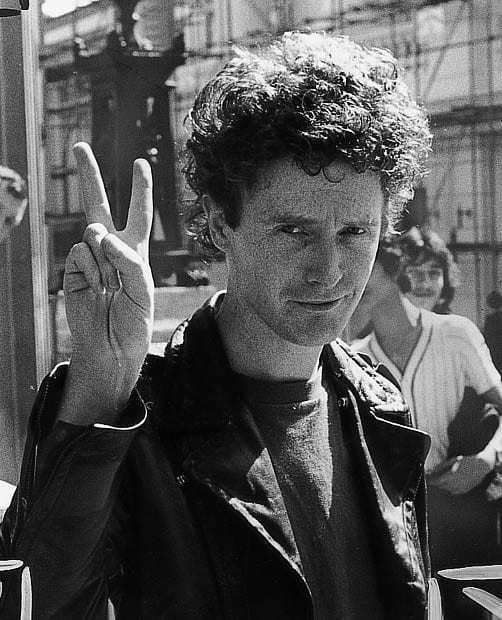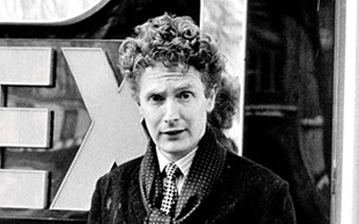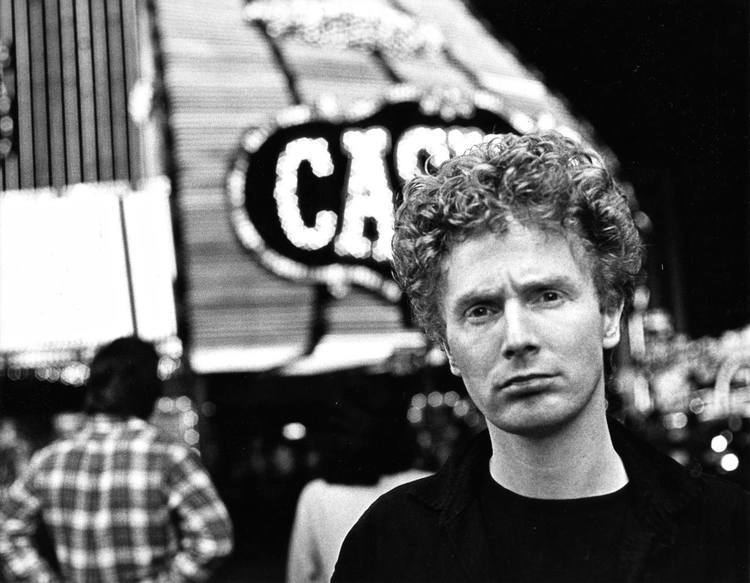Years active 1971–2010 Name Malcolm McLaren | Role Musician Children Joseph Corre | |
 | ||
Birth name Malcolm Robert Andrew McLaren Occupation(s) Musician, singer-songwriter, band manager, entrepreneur Similar People | ||
Malcolm mclaren presents double dutch wmv
Malcolm Robert Andrew McLaren (22 January 1946 – 8 April 2010) was an English impresario, visual artist, performer, musician, clothes designer and boutique owner, notable for combining these activities in an inventive and provocative way.
Contents
- Malcolm mclaren presents double dutch wmv
- Malcolm McLaren
- Early years
- New York Dolls Vivienne Westwood and SEX
- Sex Pistols
- Other artists
- Later solo musical work
- Other projects
- Visual art and exhibitions
- Posthumous exhibitions
- Later life and death
- References

Brought up unconventionally by his grandmother after his father Peter McLaren left the family home, McLaren attended a number of British art colleges and adopted the stance of the social rebel in the style of French revolutionaries the Situationists.

With a keen eye for trends, McLaren realised that a new protest style was needed for the 1970s, and largely initiated the punk movement, for which he supplied fashions from the Chelsea boutique SEX, which he operated with girlfriend Vivienne Westwood.

After a spell advising the New York Dolls in the US, McLaren managed the Sex Pistols, for which he recruited the nihilistic frontman Johnny Rotten. The issue of a controversial record, "God Save the Queen", satirising the Queen's Jubilee in 1977, was typical of McLaren's shock tactics, and he gained publicity by being arrested after a promotional boat trip outside the Houses of Parliament.

McLaren also performed as a solo artist, initially popularising hip hop and world music and later diversifying into funk and disco, the dance fashion for "voguing" and merging opera with contemporary electronic musical forms. When accused of turning popular culture into a cheap marketing gimmick, he joked that he hoped it was true.
In his later years, he lived in Paris and New York City, and died of peritoneal mesothelioma in a Swiss hospital.
Malcolm McLaren
Early years
McLaren was born on 22 January 1946 to Peter McLaren, a Scottish engineer, and Emily Isaacs in post-World War II North London. His father left when he was two and he and his brother Stuart were raised by his maternal grandmother, Rose Corre Isaacs, the formerly wealthy daughter of Portuguese Sephardic Jewish diamond dealers, in Stoke Newington.
McLaren told Andrew Denton on Enough Rope that his grandmother always said to him, "To be bad is good... to be good is simply boring". In The Ghosts of Oxford Street he says Charles Clore (who bought Selfridges) became his mother's lover. When he was six, McLaren's mother married Martin Levi, a rag trade entrepreneur; together they operated women's-wear business Eve Edwards with a factory in London's East End.
McLaren left home in his teens. After trying a series of jobs (including one as a wine taster), he attended several art colleges, including Goldsmiths, Central Saint Martins and Harrow School of Art. He left education in 1971.
In the late 1960s, McLaren was attracted to the Situationist movement, particularly the UK wing King Mob, which promoted absurdist and provocative actions as a way of enacting social change. In 1968 McLaren tried unsuccessfully to travel to Paris to join the demonstrations there. Instead, with fellow student Jamie Reid, he took part in a student occupation of Croydon Art School. McLaren later grafted some of the movement's ideas into promotion of pop and rock groups.
New York Dolls, Vivienne Westwood and SEX
In October 1971, McLaren took over the back part of the retail premises at 430 Kings Road in Chelsea, West London, and sold rock and roll records, refurbished 1950s radiograms and dead stock clothing as In The Back Of Paradise Garage. With the assistance of art-school friend Patrick Casey, McLaren converted the entire ground floor into Let It Rock, with his girlfriend Vivienne Westwood repairing original clothing and making facsimiles. McLaren and Westwood gathered custom from Teddy Boys and also designed clothing for theatrical and cinematic productions such as That'll Be The Day. In 1973, new designs in leather with studding inaugurated a new manifestation at the site with the name Too Fast To Live Too Young To Die; among commissions were costumes for Ken Russell's film Mahler.
In August 1973, McLaren and Westwood visited New York to participate in the National Boutique Fair, where they met the New York Dolls and began to supply the group with stage wear.
In October 1974, the store was renamed SEX to reflect a growing preoccupation with fetishwear and provocation.
In January 1975, McLaren and Westwood designed red patent leather costumes for the New York Dolls and used a Soviet-style hammer and sickle motif for their stage show as a provocative means of promoting the band. This ploy was not successful and the Dolls soon broke up. In April 1975, McLaren returned to Britain.
Sex Pistols
In mid-1975, McLaren advised SEX customers Paul Cook and Steve Jones on their musical aspirations, introducing them to his shop assistant, bassist Glen Matlock, and persuading them to eject guitarist/singer Wally Nightingale from rehearsals. It has been reported that McLaren's associate Bernie Rhodes (later manager of The Clash) spotted a replacement frontman in another customer, John Lydon, then sporting green hair and torn clothes with the words "I hate" scribbled on his Pink Floyd T-shirt. Lydon, dubbed "Johnny Rotten", joined and McLaren provided the name Sex Pistols (McLaren stated that he wanted them to sound like "sexy young assassins").
NME – November 1976
In May 1977, the band released "God Save the Queen" during the week of Queen Elizabeth II's Silver Jubilee. McLaren organised a boat trip down the Thames in which the Sex Pistols would perform their music outside the Houses of Parliament. The boat was raided by the police and McLaren was arrested, thus achieving his goal to obtain publicity.
The band released their album Never Mind the Bollocks, Here's the Sex Pistols in October 1977 and played their last UK gig before embarking upon a US tour in January 1978. During his time managing the band, McLaren was accused by band members (most notably by Lydon) of mismanaging them and refusing to pay them when they asked him for money. McLaren stated that he had planned out the entire path of the Sex Pistols, and in the film The Great Rock 'n' Roll Swindle he set this plan out.
McLaren kept the Sex Pistols' contract rights until Lydon took him to court in the 1980s to win the rights and unpaid revenues from McLaren. Lydon won and gained complete control from McLaren in 1987. McLaren and Lydon refused to speak to each other after the band split. In the 2000 film The Filth and the Fury, the surviving members of the Sex Pistols put their version of events on film.
Other artists
McLaren was approached by Adam Ant to manage Adam and the Ants following their debut album release in late 1979. Shortly thereafter, three members of the band left to form Bow Wow Wow under McLaren's management. McLaren continued to manage Ant as he found new band members for Adam and the Ants and worked on a new sound and also advised such groups as The Slits and Jimmy The Hoover.
The members of Bow Wow Wow also promoted clothing designed by McLaren and Westwood, and he embroiled the group in such controversies as plans to publish a magazine to be titled Chicken, to celebrate sex between individuals under the age of consent.
Later solo musical work
In 1983, McLaren released Duck Rock, an album that, in collaboration with producer and co-writer Trevor Horn and The World's Famous Supreme Team (a duo of hip hop radio disc jockeys from New York City who hosted a hip hop and classic R&B show on WHBI 105.9 FM and were among the first DJs to introduce the art of scratching to the world), mixed up influences from Africa and the Americas, including hip hop. The album helped bring hip hop to a wider audience. Two of the singles from the album ("Buffalo Gals" and "Double Dutch") became top-10 hits in the UK, with "Buffalo Gals" a minor hit in some major cities in the US.
In 1984 McLaren turned to electronic music and opera on the single "Madame Butterfly", which reached No.13 in the UK and No.16 in Australia. The producer of the single, Stephen Hague, became much sought after following his work with McLaren on the LP Fans.
McLaren's 1989 album Waltz Darling, was a funk/disco/voguing-inspired album. Waltz Darling incorporated elements of his former albums, i.e. spoken verses, string arrangements and eclectic mix of genres but featured such prominent musicians as Bootsy Collins and Jeff Beck with a glitzy, Louisiana-style production aimed at the US market. The singles, "Waltz Darling" and "Something's Jumpin' in Your Shirt" became top-20 radio hits in Europe, with the single "Deep in Vogue" bringing voguing to the attention of the world.
In 1989, McLaren and composer Yanni arranged the "Flower Duet" into a work called "Aria on Air". The "Flower Duet" theme, taken from the French opera Lakmé by Léo Delibes, had already been used by composer Howard Blake to accompany British Airways commercials since 1984. However, from 1989 McLaren and Yanni further arranged the "Flower Duet" and it featured in BA's "World's Favourite Airline" global advertising campaign of the 1980s and 1990s.
In 1992, McLaren co-wrote the song "Carry On Columbus" for the feature film of the same name. The song plays over the end credits of the film.
In 1994, he recorded the concept album Paris, with appearances by such prominent French stars as the actress Catherine Deneuve, musician Françoise Hardy and fashion designer Sonia Rykiel.
In 1998, McLaren released Buffalo Gals Back 2 Skool (Virgin Records), an album featuring hip hop artists Rakim, KRS-One, De La Soul and producer Henri Scars Struck revisiting tracks from the original Duck Rock album. That year, he also created a band called Jungk. This project was not a commercial success. Around this time he released a track called "The Bell Song" as a single available in a variety of remixes.
McLaren contributed a track, "About Her", to the soundtrack of Quentin Tarantino's 2004 film Kill Bill: Volume 2. The song is based on "She's Not There" by The Zombies, and uses Bessie Smith's "St. Louis Blues" by looping the phrase "My man's got a heart like a rock cast in the sea." Accused of plagiarism by French musician Benjamin Beduneau, McLaren was cleared in November 2005 when a court in Angers, France dismissed the case.
McLaren's solo work, particularly from the Duck Rock period, has been sampled by other artists. In 1999, a group called Dope Smugglaz had a UK Top 20 hit with the track "Double Double Dutch", which made extensive use of samples from McLaren's original "Double Dutch". In 1997, Mariah Carey's "Honey" and its "Bad Boy Remix" sampled "Hey DJ". In 2002, Eminem released a track called "Without Me", which incorporated "Buffalo Gals". In 2007, McLaren's song "World's Famous" was sampled by R&B singer Amerie on the song "Some Like It" from her album Because I Love It.
In 2001, author Paul Gorman published his book The Look: Adventures In Rock & Pop Fashion with a foreword and contributions from McLaren. The 2006 second edition included a CD featuring the track "Deux" from the Paris Remixes album.
Other projects
During the 1980s, McLaren attempted to make a film called Fashion Beast from a script by comic-book writer Alan Moore. McLaren took the project to New York City in 1986, and was for a time funded through NYC-based nightlife impresario and producer Robert Boykin. Avenue Pictures recommended screenwriter Steve Means to rewrite Moore's script. Several drafts were written, but the process slowed down with the physical deterioration of Boykin, who died in 1988. The film was never made, and McLaren declared the project "an orphan". In 2012, the film was adapted and serialised into a 10-issue comic book published by Avatar Press.
McLaren was involved with other film and television projects, including The Ghosts of Oxford Street, made for Channel 4 in 1991. This musical history of London's Oxford Street was directed and narrated by McLaren and included performances by The Happy Mondays, Tom Jones, Rebel MC, Kirsty MacColl, John Altman and Sinéad O'Connor. McLaren was also one of the producers for the 2006 film Fast Food Nation.
McLaren approached the Red Hot Chili Peppers in 1985, early in their career, expressing interest in managing them. After hearing a short live set, McLaren was "clearly unimpressed" according to frontman Anthony Kiedis. He proposed to reinvent the group by having them dress in neon clothing and play stripped-down, basic rock & roll, with all of the emphasis on Kiedis. Although Kiedis was flattered to be considered, he and the band rejected the offer. Kiedis recalled the event, saying "It was like the Wizard of Oz had spoken, and what he had said was too ludicrous to take seriously".
An article in the New Statesman, published on 20 December 1999, titled "My Vision for London", included the "McLaren Manifesto", and there was speculation that McLaren might stand to be elected as Mayor of London, although ultimately he did not run.
In 2003, McLaren wrote the article "8-Bit Punk" championing 8-bit music. He also appeared on This Spartan Life, a popular machinima that frequently uses 8-bit music, and he also discussed the topic.
In 2006, McLaren presented the documentary series Malcolm McLaren's Musical Map of London for BBC Radio 2, followed in 2007 by Malcolm McLaren's Life and Times in L.A. Also in 2007, McLaren competed in a reality TV show for ITV titled The Baron, filmed in the small Scottish fishing village of Gardenstown. The series was due to be shown in August 2007, but was postponed owing to the death of fellow contestant actor Mike Reid shortly after filming was completed. It was eventually broadcast starting on 24 April 2008. During filming McLaren was seen urinating into the harbour and loudly telling assembled inhabitants of the famously devout town, "Jesus is a sausage", at which point he was physically assaulted by a resident. McLaren came last in the competition, which was won by Reid. It was announced on 7 November 2007 that McLaren would be one of the contestants in the seventh series of the ITV reality show I'm a Celebrity... Get Me Out of Here!, set in the outback of Australia and premiering on British television on Monday 12 November 2007, but he pulled out the day he had flown to Australia. He told press "it is fake", that he didn't know any of the other celebrities and quite frankly, "he didn't have the time". He was replaced by Katie Hopkins.
In January 2008, McLaren featured as one of the 'celebrity hijackers' in the UK TV series Big Brother: Celebrity Hijack, which was broadcast on E4. In his hijack, he encouraged the housemates to remove their clothes, daub themselves in paint and produce an artwork using only their bodies and a bicycle.
About his contribution to music, McLaren has said about himself: "I have been called many things: a charlatan, a con man, or, most flatteringly, the culprit responsible for turning British popular culture into nothing more than a cheap marketing gimmick. This is my chance to prove that these accusations are true."
Visual art and exhibitions
While still an art student, McLaren has the first public exhibition of his work in 1967, which was based on an environmental installation staged at the Kingly Street Art Gallery in central London, run by a group of artists including Keith Albarn.
In 1988, McLaren's work was the subject of the exhibition Impresario: Malcolm McLaren and the British New Wave at New York's New Museum Of Contemporary Art.
In the last decade or so of his life, McLaren returned formally to the visual arts. In 1999, an installation created by McLaren was shown as part of the Bonnefanten's 1999 exhibit Smaak – On Taste in Maastricht. In 2005, this formed the basis of the exhibition Casino of Authenticity and Karaoke at the Zentrum für Kunst und Medientechnologie (Center for Arts and Media Karlsruhe) in Karlsruhe, Germany.
In 2008, New York City public arts group Creative Time premiered nine pieces of McLaren's 21-part sound painting series Shallow via MTV's massive HD screen in Times Square. The series, which was first shown at Art 39 Basel in June that year, was the first instalment of an ongoing public arts content partnership between Creative Time and MTV. The complete version of "Shallow 1–21" was given its full US museum premiere in the Morris Gallery of the Pennsylvania Academy of the Fine Arts (PAFA), in Philadelphia, from 24 October 2009 until 3 January 2010.
In 2009, JRP Ringier published McLaren's book Musical Painting, which featured contributions from other visual artists including Damien Hirst and Jim Lambie. In the afterword, publisher Lionel Bovier wrote, "Malcolm McLaren is and has been artist in the purest sense for his entire adult life."
At the time of his death, McLaren had recently finished a new film work entitled Paris: City Of The XXIst Century, which was first shown at the Baltic Centre for Contemporary Art in Gateshead, UK.
In 2011, the US performance-art biennial festival Performa instituted The Malcolm, an award for the most thought-provoking entry named after McLaren and designed by Marc Newson.
In 2013, The Costume Institute of the New York Metropolitan Museum of Art exhibition "Punk: From Chaos To Couture" included the section "The Couturier Situationists" dedicated to McLaren and Westwood.
Posthumous exhibitions
An exhibition about McLaren's engagement in fashion was held as part of the Copenhagen International Fashion Fair in August 2014. "Let It Rock: The Look of Music The Sound of Fashion" was curated by Young Kim and Paul Gorman and included sections focusing on each of the six retail outlets McLaren operated with Vivienne Westwood. Original clothing, photographs and ephemera were loaned by the Malcolm McLaren Estate archive and such collectors as British fashion designer Kim Jones and musician Marco Pirroni.
British fashion writer Charlie Porter praised the curation, writing on his blog: "At the Maclolm McLaren show in Copenhagen, the hang of the garments is exceptional."
McLaren's background in the visual arts as a student and practitioner was a major focus of the exhibition Art in Pop held at contemporary art gallery Le Magasin, the Centre National d'Art Contemporain in Grenoble, France, from October 2014 to February 2015. "The main central space is dedicated to Malcolm McLaren, who embodies more than anyone the breaking open of perceptions of what constitutes an artist," wrote Magasin's Yves Aupetitallot in the exhibition introduction.
Aupetitallot curated Art in Pop with Paul Gorman, Young Kim and participating artists John Armleder and John Miller. The exhibition also included contributions from musicians Daniel Johnston, Don Van Vliet (Captain Beefheart), Genesis Breyer P-Orridge and Alan Vega as well as artists who have engaged with music such as Alix Lambert and Takuji Kogo.
The McLaren space at Art in Pop included original examples of fashion designs created with Westwood, including loans from Kim Jones, Marco Pirroni, anthropologist/writer Ted Polhemus and streetwear guru Hiroshi Fujiwara. Photography, ephemera and images from a 1969 student art show were displayed, as well as a painting from the mid-'80s entitled "I Will Be So Bad". The exhibition also included a soundtrack of music made by McLaren, prompting Marie France to describe it as "an invigorating exhibition not just to see but hear as well".
Later life and death
McLaren met Korean-American Young Kim at a party in Paris; she was his girlfriend for the last 12 years of his life. She moved in with him in 2002, and they lived together in Paris and New York. He was diagnosed with peritoneal mesothelioma in October 2009, and died of the disease on 8 April 2010 in a hospital in Switzerland. McLaren's last words were claimed by his son Joseph Corre to have been "Free Leonard Peltier".
Tributes poured in from many of McLaren's friends, associates and fans including John Lydon, who had been at odds with McLaren since the demise of the Sex Pistols. "For me Malc was always entertaining, and I hope you remember that. Above all else he was an entertainer and I will miss him, and so should you." Lydon said in a statement as Johnny Rotten.
In a coffin sprayed with the slogan "Too Fast To Live Too Young To Die", McLaren's funeral was attended by Westwood and Sex Pistols band members Paul Cook and Glen Matlock along with celebrities such as Bob Geldof, Tracey Emin and Adam Ant. The funeral was held at One Marylebone, a deconsecrated church in central London.
McLaren's body was buried in Highgate Cemetery, North London, to the strains of the Sid Vicious version of "My Way".
In 2012, probate was granted to Young Kim by McLaren's will, which excluded his son Joe Corre from the inheritance.
In April 2013, a headstone was placed on McLaren's grave featuring the slogan "Better a spectacular failure, than a benign success", a misquote of McLaren's claim that the best advice he received came from an art-school teacher, "It is better to be a flamboyant failure than any kind of benign success".
